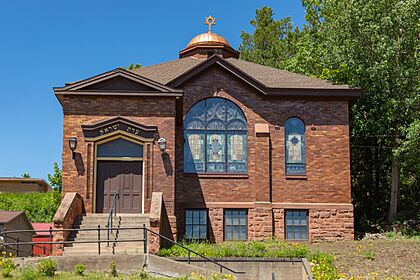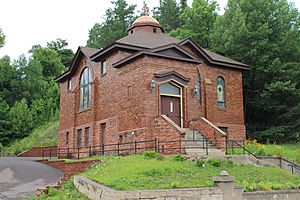Temple Jacob facts for kids
Quick facts for kids Temple Jacob |
|
|---|---|

Temple Jacob, in 2021
|
|
| Religion | |
| Affiliation | Reform Judaism |
| Ecclesiastical or organizational status | Synagogue |
| Status | Active (seasonal) |
| Location | |
| Location | 301 Front Street, Hancock, Michigan 49930 |
| Country | United States |
| Architecture | |
| Architect(s) | Maass Brothers |
| Architectural type | Synagogue architecture |
| Architectural style | Georgian Revival |
| Date established | 1889 (as a congregation) |
| Completed | 1912 |
| Materials | Jacobsville sandstone |
Temple Jacob, also known as the Congregation of Israel, is a special synagogue located in Hancock, Michigan. It is a place of worship for people who follow Reform Judaism, a branch of the Jewish faith. This historic building is found at 301 Front Street in the Upper Peninsula of the United States.
This congregation started during a time when many people came to the Keweenaw Peninsula for copper mining. Temple Jacob was the first Jewish synagogue in the "Copper Country" area. It is also the oldest Jewish house of worship in the Upper Peninsula that is still active today. It is even listed on the National Register of Historic Places, which means it is an important historical site.
The synagogue is close to the bridge that connects the towns of Houghton and Hancock. It was built on land bought from the Quincy Mining Company. The building was officially opened in September 1912. A special stone on the building remembers Jacob Gartner, who gave a lot of money and helped raise funds for the temple. He passed away just before the building was finished.
Building Design and Features
The architects, Maass Brothers, created the plans for Temple Jacob. J. J. Kelly built the strong foundation using Jacobsville sandstone. A. J. Verville then finished the main structure of the building. The walls are made of a special glazed brick.
The temple has a hip-shaped roof and measures about 40 feet by 40 feet (about 12 by 12 meters). A copper dome sits on top of the roof. The windows are rounded and have beautiful stained glass. These windows show symbols like a dove with an olive branch, a shofar (a ram's horn), a burning bush, Noah's Ark, hands in blessing, the Star of David, an eternal light, and the Ten Commandments tablets. Inside, the temple is set up in a traditional Jewish way. The Torah ark, which holds the holy Torah scrolls, is on the east wall. There used to be a balcony where men and women sat separately during prayers.
Temple Jacob's History
The Congregation of Israel began in 1889. At that time, more and more Jewish families were moving to the Copper Country. By 1910, when copper mining was at its busiest, there were about 100 Jewish families living there. However, by the time the synagogue was completed in 1912, the demand for copper started to decrease. This led to fewer people living in the area, including the Jewish community.
Temple Jacob first started as an Orthodox congregation. Over time, it changed to become a Reform synagogue. Many smaller synagogues across the U.S. made similar changes. In the 1930s, a local businessman named Norbert Kahn helped some of his relatives move from Germany to the Upper Peninsula. He wanted them to escape the difficult situation in Germany before World War II.
A Difficult Event
On September 21, 2019, a young man caused damage to the outside of Temple Jacob. He spray-painted symbols, including swastikas, on the building. This act was part of a larger plan by a group with harmful ideas. People who were involved in this incident later admitted to federal crimes related to what happened.
Recent Activities
Even though the number of Jewish people in the area decreased for many years, new families have continued to arrive. In recent times, a small but active group of people helps keep the synagogue going. This group includes professionals, professors from Michigan Technological University, summer visitors, and local Jewish residents. They also have many kind friends who support them.
They keep Judaism alive in the Copper Country by holding services for the High Holy Days with a visiting rabbi. They also have Passover Seders, Torah study sessions, and celebrate holidays like Sukkot and Tu BiShvat. They even help send children to Jewish summer camp.
Temple Jacob is now one of only two Jewish congregations in the Upper Peninsula. Another synagogue in Iron Mountain closed in 2020. The other active synagogue is Temple Beth Sholom in Marquette.


